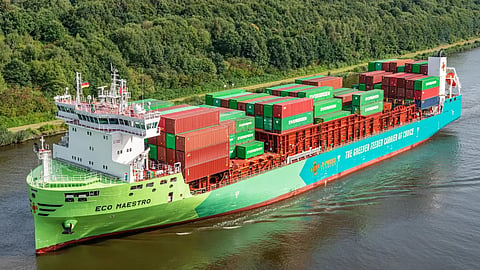VESSEL REVIEW | Eco Maestro – X-Press Feeders deploys methanol-fuelled boxship quartet on European routes
Singapore-based liner company X-Press Feeders recently took delivery of four new container vessels in a series built by China’s Jiangsu Yangzijiang Shipbuilding.
Eco Maestro, Eco Levant, Eco Ponente, and Eco Zephyr are among 14 dual-fuel vessels X-Press Feeders has on order. The company plans to deploy these vessels mostly on routes in Europe, creating Europe’s first feeder network powered by green methanol.
The initiative coincides with the EU’s upcoming implementation of an emissions trading scheme (ETS) for maritime shipping. Fuel EU Maritime regulations starting in January 2025 will also mandate the reduction of greenhouse gas (GHG) emission intensity on energy used on board ships.
Serving a new methanol corridor in Europe
X-Press Feeders said green bio-methanol is a more sustainable fuel because it is a renewable energy source produced from the decomposition of organic matter, such as waste and residues. The company is using green methanol that is supplied by OCI Global and independently certified in Europe under International Sustainability and Carbon Certification (ISCC).
X-Press Feeders Chief Operating Officer Francis Goh said the company chose northern Europe for the first routes in the network. This is because customers in this part of Europe were most receptive to plans for sustainable shipping. The company chose the Port of Rotterdam as the base for Europe’s first feeder network powered by green methanol because Rotterdam is Europe’s largest port and is fully equipped to handle green methanol refuelling.
Each of the four new vessels has a steel hull, an LOA of 148 metres (486 feet), a beam of 27.2 metres (89.2 feet), a structural draught of 8.1 metres (27 feet), a depth of 14.3 metres (46.9 feet), a deadweight tonnage of 13,675, a gross tonnage of 16,242, and a maximum container capacity of 1,260 TEUs. Up to four different sizes of containers can be carried on each voyage.
A 5S50ME dual-fuel main engine from MAN can also operate on methanol and will drive a controllable-pitch propeller to deliver speeds of up to 14 knots. The methanol on each ship is stored in two dedicated fuel tanks. The rest of the propulsion arrangement consists of two Cummins K50-D(M) main generators, a Cummins NT855-M emergency generator, and a Kawasaki Heavy Industries KT-88B3 side thruster.
Four ships for two feeder routes
The methanol propulsion also ensures fuel consumption tonnage per nautical mile can be reduced by as much as 50 per cent compared to conventional marine fuels, thus further reducing emissions.
Eco Maestro will sail under the Maltese flag while its three sisters are all registered to France. The four ships will serve two feeder routes: Rotterdam-Antwerp Bruges-Helsinki-Tallinn-HaminaKotka-Rotterdam and Rotterdam-Antwerp Bruges-Klaipeda-Riga-Rotterdam.
Design work on all four newbuilds was provided by the Marine Design and Research Institute of China (MARIC) in compliance with DNV class rules.


